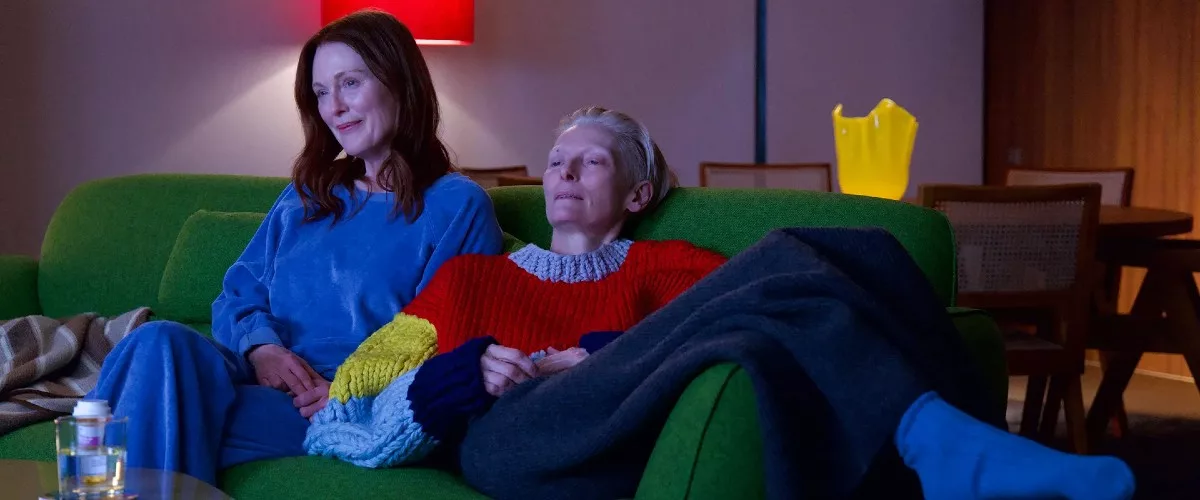Many of us would like to think we’re a good friend to the people in our lives. We’re ready to meet up for a cup of coffee, catch-up dinners, or send friendly messages when needed. Hell, some of us might even be willing to help a friend move (again) or send a much-needed meal in a time of grief. But in Pedro Almodóvar’s English-language debut “The Room Next Door,” the answer of how far you would go for a friend is put to the test.
At a book signing, author Ingrid (Julianne Moore) learns that her estranged friend Martha (Tilda Swinton) is fighting cancer and decides to reconnect. The pair were close years ago, and when they reunite, it’s as if no time had passed. In between cancer treatments, Martha shares her life story with Ingrid – almost as if racing against time – recounting her problems with her distant daughter Michelle, the tragedy of her high school sweetheart Fred, and the lessons she learned as a war reporter. Finally, the bad news arrives that Martha is not getting better. Desperate not to die in agony, she plans to end her life, “Cancer can’t get me if I get me first.” In the process, Martha inadvertently creates the ultimate friendship test: would the death-phobic Ingrid help her enjoy her last days before Martha decides to end her own life?
Based on Sigrid Nunez’s novel What Are You Going Through, “The Room Next Door” is an emotional two-hander between acting titans. As Ingrid, Moore is the audience’s surrogate, trying to do her best with an impossible task, perhaps sympathetic to a fault, yet she gracefully attempts to deal with the grief of losing her friend without making Martha uncomfortable. She might seem like a pushover at times, but everything she does in this movie comes from a place of love in trying to support her ailing friend. Swinton is graceful in a different manner. Her performance feels restrained, holding on to a stiff upper lip even as if her character looks like she’s physically holding back the pain from appearing on her face. She loses her cool here and there as if to remind us she too is only human. Martha’s story soon overtakes Ingrid’s spotlight, one tangent and conversation rolling into another, but this dance between perspectives vacillates throughout the film until Martha’s and Ingrid’s stories briefly become one in the same.
While this is Almodóvar’s return to feature filmmaking after the two shorts “The Human Voice” and “Strange Way of Life,” his latest movie is not quite a return to form for the master craftsman. “The Room Next Door” feels like it’s missing the dialogue rhythm and unrestrained emotions of movies like “Tie Me Up! Tie Me Down!,” “Women on the Verge of a Nervous Breakdown,” “Talk to Her,” Volver,” and “The Skin I Live In.” Even as his quieter recent films like “Pain and Glory” and “Parallel Mothers” engage in unspoken emotions and deeper themes, “The Room Next Door” stays a little closer to the surface, completing what feels like only 3/4 of a full journal entry. For the kind of story and the skilled actors Almodóvar brought in for this project, I was actually surprised how little this film did make me feel by the credits. It’s almost too restrained and stilted in a way that appears like a miscalculation.
However, Almodóvar continues to surprise and delight through his masterful use of color and composition. Since his earliest 16mm punk DIY roots, Almodóvar has shown a prodigious attention to color that few other directors can rival. In movies like “All About My Mother,” the palette is made up of bold and delicious primary colors that catch your attention as much as the story. The wall colors pop as much as the bright clothes and accessories, creating an idiosyncratic visual style that remains his signature many decades into an illustrious career. In “The Room Next Door,” contrasting hues of green and red battle to draw our eyes to each respective star. Ingrid’s cool blue apartment assembled out of found objects is a world away from Martha’s slick, green-tinged apartment with a balcony garden. Almodóvar seems to take Moore’s bright red lipstick and striking hair color as a challenge to match her with the set design and outfits, but there’s not a bad choice on screen at any moment. After all these years, it’s still dazzling to watch what Almodóvar does with his canvas.
Quiet yet moving, “The Room Next Door” is a heartfelt meditation on friendship, grief, and death. We don’t know when we’ll be called upon to support a friend through a crisis, but it is a gesture of love if we can be and choose to be there for them. At one point in the film, we meet a former flame Ingrid and Martha shared back in the day, Damian (John Turturro), who arrives in the story to support Ingrid in this odd time but also shares his pessimism for the world’s future in a conversation over lunch. Ingrid is perhaps now less afraid of death than of losing hope and the will to savor every moment we share with friends and loved ones. She argues with him against letting negativity destroy his ability to enjoy life. To paraphrase Frank Sinatra’s famous quote, I’m for anything that helps you be a better friend, a better neighbor, a better human being in a world where death comes for us all and life is only as good as the days you can savor and the times you can be there for the people who matter to you.




















